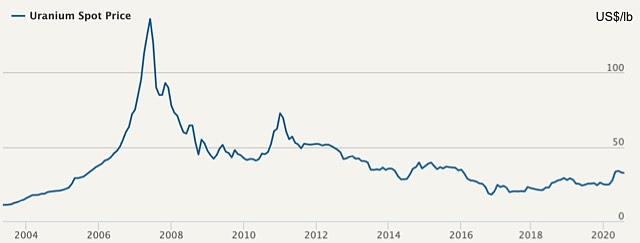Big question mark over uranium supply brewing

Uranium’s spot price has already risen 30% for the year, however supply issues could see its price continue to rise.
Even with the world’s biggest uranium mine to reopen next month, a survey of analysts shows that there are still concerns there will be a supply shortfall throughout next year running into 2022.
The news that Cameco would reopen its Cigar Lake mine in Saskatchewan in September, and Orano would be reactivating its McClean Lake uranium mill to process ore from Cigar Lake, sent only a minor tremble through the spot market.
In fact, the spot price rose from US$32.20 per pound on 27 July to US32.80/lb on 4 August.
Commentary on the reopening of Cigar Lake (closed in March to protect workers during the COVID-19 virus) is that the event will not have a serious impact on the supply shortfall.
Several analysts have made similar comments to those from Oscar Cabrera at CIBC World Markets: that is, there’s going to be uranium deficit this year and next.
According to industry watcher TradeTech the mine closures due to the pandemic have cut about 14Mlb — that is 6,350 tonnes — from mine supply so far in 2020.
World’s top producer still hit by virus
The people at KazAtomProm, Khazakhstan’s national atomic agency — the world’s number one exporter of uranium oxide — have signalled they remain “severely” impacted by the COVID-19 pandemic.
KazAtomProm has said it will maintain a 20% reduction in uranium production in 2021. This will result in the removal of up to 5,500t of uranium from the projected global supply into 2022.
The impact of this can be judged by the fact that Kazakhstan in 2019 produced 43% of the world’s uranium (against Canada’s 13% and Australia’s 12%).
The bottom line: spot uranium’s price is still up 30% for the year, with seemingly little prospect of it coming under any severe pressure.

The uranium price will need to range between $40-80 for new and idle mines to come online.
The S&P Global Platts forecast for the average spot price over the next 12 months is US$31.43/lb — not quite enough to put some extra fire under the uranium story.
But the facts suggest this forecast may be too pessimistic — and while the spot price is followed closely, it is not the be-all and end-all.
For example, Paladin Energy (ASX: PDN) has a plan to restart its 75%-owned Langer Heinrich uranium mine in Namibia. The production cost is estimated at US$27/lb — but Paladin has stated quite specifically it will be looking for long-term contracts, which will be set at prices much higher than the spot.
Paladin’s recent presentation on its restart plan runs parallel to facts being shared by other uranium companies and shows that there is, indeed, going to be a supply crunch.
Already, current world mine production is unable to meet demand, and has been falling behind since 2018.
Utilities not buying enough uranium for future needs
It looks like it will be around 2030 before there will be any substantial number of new or re-opened mines being added to the current total.
Paladin makes the point that to restart idled mines and bring new ones into production will require the miners receive somewhere between US$40/lb and US$80/lb for their product.
Meanwhile, power utilities are facing an issue. Since 2012, they have been “under buying” uranium to the tune of about 90Mlb a year relative to consumption, according to Paladin. In tonnage terms, that’s more than 40,800t.
Some supply contracts pre-date the Fukushima disaster in 2011 and Paladin notes that many US and European utilities have largely run down their stockpiles.
“Asian utilities have higher stockpiles than their Western counterparts, but these are also decreasing,” the company said.
Not enough new uranium mines in pipeline
In May, Small Caps reported the comments from Deep Yellow (ASX: DYL) managing director John Borshoff that put into stark relief the problems being faced by the uranium industry.
Mr Borshoff, who founded Paladin and took it public in 1994, issued a stark warning about future uranium supply shortages, saying the mining sector is “totally unprepared” to meet the challenges of the looming yellowcake shortage.
He believes that uranium supply is in a “fragile and precarious” situation with most of the players ill-prepared to face the future challenges.
There has been a massive attrition of players since the 9.0-point earthquake (the fourth largest in recorded history) struck eastern Japan on 11 March 2011, triggering a tsunami that massively damaged the Fukushima nuclear power plant.
In 2011, pre-Fukushima, the prevailing uranium price was US$73/lb.
Also, as of April, there were 441 reactors in operation globally, 54 under construction, 111 planned, 328 proposed.
On the supply side, there are now about 62 companies exploring for uranium. In 2011 that number had been 420.
